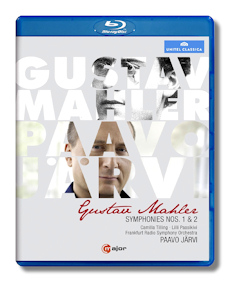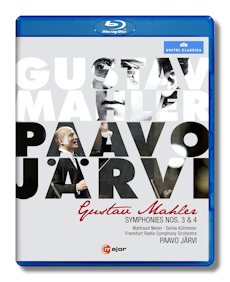
The Internet's Premier Classical Music Source
Related Links
- Mahler Reviews
- Latest Reviews
- More Reviews
-
By Composer
-
Collections
DVD & Blu-ray
Books
Concert Reviews
Articles/Interviews
Software
Audio
Search Amazon
Recommended Links
Site News
 Blu-ray Review
Blu-ray Review
Gustav Mahler

- Symphony #1 "Titan"
- Symphony #2 "Resurrection" *
* Camilla Tilling, soprano
* Lilli Paasikivi, mezzo-soprano
* Chorus of the Bavarian Radio
* NDR Chorus
Frankfurt Radio Symphony Orchestra/Paavo Järvi
Recorded live at Friedrich-von-Thiersch-Saal Kurhaus, Wiesbadan, Germany - August 23, 2012 (#1); Kloster Eberbach, Eltville am Rhein, Germany - June 26 & 27, 2010 (#2)
Bonus Track – Introduction to the Symphonies by Paavo Järvi
Unitel Classica/C Major Blu-ray 718104 149m + 20m (bonus) PCM Stereo DTS-HD Master Audio
Also available on DVD 718008:
Amazon
- UK
- Germany
- Canada
- France
- Japan
- ArkivMusic
- CD Universe
- JPC


- Symphony #3 *
- Symphony #4 **
* Waltraud Meier, mezzo-soprano
** Genia Kühmeier, soprano
* Limburger Domsingknaben
* MDR-Rundfunkchor Leipzig
Frankfurt Radio Symphony Orchestra/Paavo Järvi
Recorded live at Kloster Eberbach, Eltville am Rhein, Germany - June 23 & 24, 2007 (#3); June 28 & 29, 2008 (#4)
Bonus Track - Paavo Järvi's Mahler
Unitel Classica/C Major Blu-ray 719204 165m + 18m (bonus) PCM Stereo DTS-HD Master Audio
Also available on DVD 719108:
Amazon
- UK
- Germany
- Canada
- France
- Japan
- ArkivMusic
- CD Universe
- JPC
These are the first two volumes of Paavo Järvi's cycle of the complete Mahler symphonies, and for once the works are being issued in chronological order. Oddly, symphonies #2, 3 & 4 seem to come from a different technological world from that of #1. The First Symphony is presented with excellent picture clarity and very vivid sound reproduction, but the succeeding three symphonies are given a comparatively inferior treatment. They look and sound more like DVD quality than Blu-ray, but that might be due to the fact the First was recorded in a different location from that of the other three. The venue for the Second, Third and Fourth – the historic Eberbach Abbey Church – has rather reverberant acoustics, which of course can negatively impact sonic properties. Actually, with the volume cranked up a bit, the sound is reasonably good in the three symphonies recorded there, more than adequate to enjoy the music. Regarding the picture quality, it features somewhat washed out colors and a less sharp picture. Again, the location could be the problem: the lighting in this very old and large church appears to be somewhat inadequate, and that could account for the faded colors as well as loss in picture quality.
One notes that the First was the most recently recorded of the four symphonies – 2012, compared to 2010 for the Second, 2007 for the Third, and 2008 for the Fourth. That shouldn't account for the noted differences, but it could be an additional factor. Whatever the case, I can live with such shortcomings as they are ultimately rather minor, especially if the performances are good – and they are quite good. Indeed, the Second actually appears to be slightly better than the impressively played First, and the Third is better still. The Fourth is also a very convincing performance, maybe at the level of the Third. But let's take a closer look at all of the symphonies.
Järvi's First is a fairly brisk affair, though some of the slow music is taken quite slowly but not overly so. It's not exactly a case of tempo extremes here, as the conductor always puts forth a good case for his tempo selections, with contrasts in pacing seeming natural and wisely conceived. Overall, he draws out an energetic and richly atmospheric first movement from the excellent Frankfurt Radio Symphony Orchestra and he draws out a folk-like, spirited second movement. The third movement Klezmer music could be a little more wanton, though everything else is splendidly played. The finale features a grandiose ending and masterly shaping and execution of what I believe is a somewhat overlong movement. This is a very good performance then, but one that is bettered somewhat by Abbado and the Lucerne Festival Orchestra (EuroArts DVD 2057968).
I mentioned the slightly washed-out colors of the picture in the other three symphonies, but ironically Järvi delivers a performance of the Second not lacking in color at all, as he deftly captures all the work's ranging emotions and moods: the drama and turbulence of the opening panel; the playful innocence and joy of the ensuing movement; the humor and menace of the Scherzo; the heavenly serenity of the Urlicht; and the cathartic triumph of the finale, which comes on with ample power despite what appears to be a smaller chorus. The space in the church is limited and that may well be the reason for the apparently reduced size. Lilli Paasikivi sings splendidly in the Urlicht and finale and Camilla Tilling is utterly angelic in that final movement as well. In the end, this performance must be judged as excellent and can stand with the better video versions by Boulez (EuroArts Blu-ray 2054424) and Chailly (Accentus Blu-ray ACC10238).
The Third is outstanding. The first movement is vigorous and very potent, the march music energetic and bursting with an ecstatic joy, the playing accurate and committed. The ensuing movement is charming, its minuet music having grace and lightness and the faster sections providing nice contrast with its deft wit and hints of menace. Järvi and his forces impart much energy and color to the livelier music in the lengthy Scherzando, while the post horn solo, coming from way in the back of the church on the right side very near members of the audience, is well played and has a real dreamy and serene sense, perhaps aided by the reverberant acoustics. Järvi is very fortunate that he has the great Waltraud Meier as his soloist in the fourth and fifth movements: she certainly lives up to her lofty reputation as she sings with mesmerizing beauty and outstanding dramatic skill. Bravo! No one else comes to mind who sings this better than Meier. The brief fifth movement also features splendid singing by the choirs. Järvi takes the opening chorale melody in the finale with an appropriate majesty without pacing it too slowly, as many conductors do. The symphony ends in utter grandeur and triumph. This is one of the finest Mahler Thirds ever recorded. Also, excellent is the 2008 Abbado DVD (EuroArts/Medici Arts DVD 2056338). The Mehta is impressive too, but is an audio-only Blu-ray (Farao Classics Blu-ray Audio A108087).
As for the Järvi Mahler Fourth, it is well played in all movements, though I particularly like the lengthy third movement, and how Järvi coaxes out that swooning effect from the strings and builds the music to such passionate outpourings. The first movement is very lively and playful, but Järvi and the Frankfurt Radio players give the music a little bit of an edginess and crispness too. The second movement's quirky qualities and charm come through in spirited and brilliant playing by the orchestra, the solo work by the concertmaster and others having a strong sense of character and color. In the finale, again the orchestral playing is splendid, but the utterly exuberant and beautiful singing by Genia Kühmeier nearly steals the show. She sings with such energy and charm, winning you over from her first notes. In the end, this must be assessed as a great Mahler Fourth performance all around. I reviewed another video version of the Mahler Fourth here in 2013, the Gergiev DVD (Unitel Classica/CMajor DVD 702608) and found it quite good. I would now, however, give the edge to Järvi as far as video versions are concerned.
If one needed to sum up in a few words Paavo Järvi's style of interpreting Mahler, I would say his way with the music is energetic, spirited and colorful, rarely sounding ponderous or bogged down. Slow music never sounds too slow and fast music comes across as lively and judiciously paced, never hasty. No eccentricities here, then. All four of these interpretations are very good to excellent and can thus compete with the better or even the best versions available. Strongly recommended.
Copyright © 2015, Robert Cummings





















